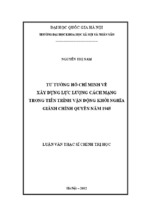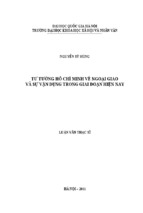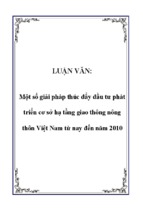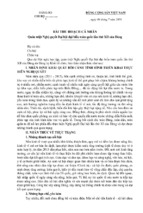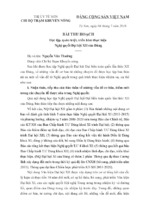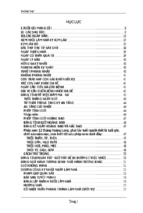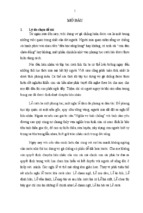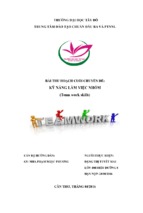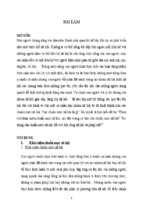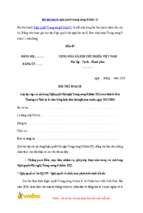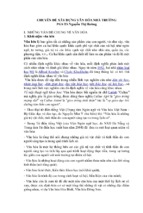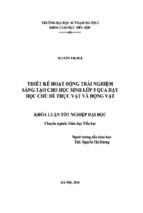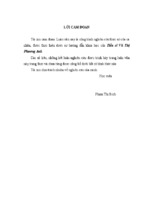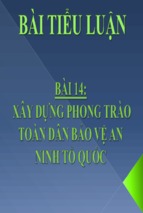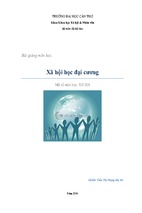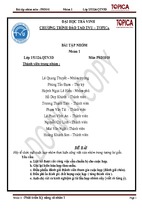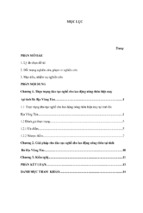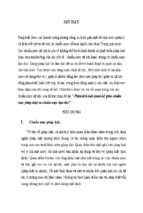Mô tả:
Pictures can move people, stir up curiosity, provide inspiration and motivation
for speaking, and generally enhance learners’ classroom experience (Keddie, 2009:7) .
With the use of pictures in speaking activities, the current research aims at (1)
investigating to what extent young learners can improve their speaking skill, and (2)
exploring their attitudes towards the use of pictures in the activities.
To achieve the first purpose of the study, the author conducted an experimental
research at New Oriental English School with the use of pictures in speaking activities
for the Experimental group (EG) consisting of sixteen students, and without the use of
pictures in speaking activities for the Control group (CG) consisting of sixteen
students. To measure the development of learners’ speaking skill before and after the
treatment, the researcher used a pre-test and a post-post to compare the mean scores of
the two groups. As a result, although there was no statistically significant difference
between the two groups before and after the treatment, the mean scores of the post-test
showed that the EG outperformed the CG. In addition, observations, questionnaires,
and interviews were employed to explore learners’ attitudes towards the use of
pictures in speaking activities. The results revealed that learners in the EG showed
their great interests and motivation, and responded positively to wards the application
of pictures in learning speaking.
Finally, basing on the findings, the research offered some recommendations for
teachers and school administrators and suggestions for further research relating to the
use of pictures in teaching and learning English, especially for teaching and learning
English speaking skill.
v
TABLES OF CONTENTS
STATEMENT OF AUTHORSHIP.................................................................................. i
RETENTION AND USE OF THE THESIS….. ............................................................. ii
ACKNOWLEDGEMENT ............................................................................................... iii
ABSTRACT….. ................................................................................................................ iv
TABLE OF CONTENTS .................................................................................................. v
LIST OF FIGURES, CHARTS AND TABLES….. ....................................................... x
ABBREVIATIONS.......................................................................................................... xii
Chapter 1: INTRODUCTION.......................................................................................... 1
1.1. Statement of the problem.............................................................................................. 2
1.2. Statements of the purpose ............................................................................................. 3
1.3. Research questions ....................................................................................................... 3
1.4. Significance of the study .............................................................................................. 4
1.5. Limitation of the Study ................................................................................................. 4
1.6. The Organization of the Study ..................................................................................... 4
Chapter 2: LITERATURE REVIEW ............................................................................. 6
2.1. Communicative competence ....................................................................................... 6
2.1.1. Communicative language teaching ................................................................. 7
2.1.2 The practice of teaching and learning speaking skill in classroom .................. 8
2.1.3. The teaching of spoken language functions in classroom activities ................ 9
2.1.4. Children proficiency of learning spoken language......................................... 12
2.1.5. Children’s ability for meaning negotiation and demands for more complex
tasks ................................................................................................................ 13
2.1.5.1. Children’s ability for meaning negotiation .................................................. 13
2.1.5.2. Children’s demands for more complex tasks ............................................... 13
2.2. The use of visual aids in language teaching ............................................................... 14
2.2.1. Definitions of pictures ................................................................................... 15
2.2.2. Types of pictures ........................................................................................... 16
vi
2.2.3. Activities used with pictures to teach oral skills for children ....................... 17
2.3. The importance of motivation in language teaching and learning activities .............. 18
2.3.1. Types of motivation ....................................................................................... 18
2.3.2. Factors and elements of motivation............................................................... 19
2.3.3. Maintaining learners’ motivation .................................................................. 20
2.4. Previous studies and articles related to the current research ...................................... 21
Chapter 3: RESEARCH METHODOLOGY….. ......................................................... 24
3.1. Research context ......................................................................................................... 24
3.1.1. Research site ................................................................................................. 24
3.1.2. Teaching materials........................................................................................ 25
3.1.3. The main teaching staff ................................................................................ 25
3.1.4. The current teaching and learning English speaking skill at NOES ............ 25
3.2. The population of the research ................................................................................... 26
3.2.1. Research samples.......................................................................................... 26
3.3. Research design .......................................................................................................... 30
3.4. Design of lesson plans for CG and EG ....................................................................... 32
3.4.1 A description of the lesson plan for the CG .................................................. 32
3.4.2. A description of the lesson plan for the EG ................................................. 34
3.5. Research Instruments.................................................................................................. 36
3.5.1. The pre-test and post-test design .................................................................. 37
3.5.1.1. The pre-test contents ................................................................................. 40
3.5.1.2. The post-test contents ................................................................................ 40
3.5.2. Observation................................................................................................... 41
3.5.3. Survey Questionnaire ................................................................................... 43
3.5.4. Interview ....................................................................................................... 47
3.6. Procedures of data collection...................................................................................... 48
3.7. Analytical framework ................................................................................................ 49
3.7.1. Experimental data analysis ........................................................................... 50
3.7.1.1. Mean (X) ................................................................................................... 50
3.7.1.2 Standard Deviation (S.D.) .......................................................................... 50
vii
3.7.1.3. Independent samples T-test ....................................................................... 50
3.7.1.4. Pair samples T-test .................................................................................... 50
3.7.2. Descriptive data analysis .............................................................................. 51
3.7.2.1. Frequencies (f) ........................................................................................... 51
3.7.2.2. Percentages (%) ......................................................................................... 51
3.7.3. Content analysis............................................................................................ 51
CHAPTER 4: FINDINGS OF THE STUDY ................................................................ 53
4.1. Participants’ performance at pre-test and post-test .................................................... 53
4.1.1. Comparisons of Mean scores and Independent Samples T-test of CG and
EG in Pre-test ........................................................................................................... 54
4.1.2. Comparisons of paired samples T-test of CG and EG after treatment .......... 54
4.1.2.1. Paired samples T-test of CG on Pre-test and Post-test ............................... 54
4.1.2.2. Paired samples T-test of EG on Pre-test and Post-test ............................... 55
4.1.2.3 An Independent Samples T-test of CG and EG on Post-test ....................... 56
4.2. Learners’ attitudes toward the use of pictures in speaking activities ......................... 57
4.2.1. Analysis of observations for EG .................................................................... 57
4.2.2. Results of the research questionnaires ........................................................... 59
4.2.2.1. Learners’ opinions about the use of pictures in speaking English ............. 59
4.2.2.2. Levels of learners’ interest in speaking activities through pictures............ 62
4.2.2.3. Learners’ evaluation on the levels of difficulty for each activity with the
use of pictures in speaking ....................................................................................... 65
4.2.2.4.Learners’ recommendations or suggestions................................................. 68
4.2.3. Results of the interviews ................................................................................ 59
4.2.3.1. Learners' opinions about the use of pictures in speaking ........................... 59
4.2.3.2. Learners’ opinions about speaking activities through pictures .................. 70
4.2.3.3. Learners’ perspectives on the helpfulness of pictures in speaking
activities ................................................................................................................... 73
4.2.3.4. Learners’ suggestions about the use of pictures in speaking activities ...... 74
Chapter 5: Discussions of the findings.......................................................................... 76
viii
5.1. To what extent the use of pictures affects the development of the learners’
speaking skill ..................................................................................................................... 76
5.2. Learners’ attitudes toward the use of pictures in speaking activities ......................... 77
5.2.1. Learners’ interest and motivation about the use of pictures in English
speaking ................................................................................................................... 77
5.2.2. Learners’ opinions about the usefulness of pictures in speaking English ..... 78
5.2.3. Learners’ responses to specific speaking activity through pictures .............. 79
5.2.3.1. Talk as transaction (Information exchanging) ............................................ 79
5.2.3.2. Talk as performance (Information presenting) ........................................... 80
5.2.4. Learners’ recommendations or suggestions................................................... 82
5.3. Chapter Conclusion .................................................................................................... 82
CHAPTER 6: CONCLUSION AND RECOMMENDATIONS ................................. 84
6.1. Conclusion .................................................................................................................. 84
6.1.1. Effectiveness of using pictures to enhance learners’ speaking skill ............... 84
6.1.2. Learners’ attitudes towards the use of pictures in speaking activities ............ 84
6.2. Limitations of the research ......................................................................................... 84
6.3. Recommendations ...................................................................................................... 86
6.3.1. Recommendations for teachers and the school administrators ....................... 86
6.3.2. Recommendations for further research ........................................................... 88
6.4. Contribution of the study ............................................................................................ 88
REFERENCES ................................................................................................................ 89
APPENDIXES.................................................................................................................. 95
Appendix A: A sample of a lesson plan for the Control Group ....................................... 95
Appendix B: A sample of the lesson plan for the Experimental Group ............................ 97
Appendix C: A description of speaking assessment criteria ............................................. 89
Appendix D: Pre-test handout ......................................................................................... 100
Appendix E: Post-test handout ........................................................................................ 103
Appendix F: The Observation Checklist ......................................................................... 106
ix
Appendix G: Pre-survey questionnaire for teachers........................................................ 107
Appendix I: Questionnaire for students ........................................................................... 109
Appendix H: Interview questions for learner participants .............................................. 112
Appendix J: Sample Transcripts of students’ performance in Speaking Pre-test ........... 114
Appendix J1: Sample Transcripts of CG in Speaking Pre-test ........................... 114
Appendix J2: Sample Transcripts of EG in Speaking Pre-test............................. 121
Appendix K: Sample Transcripts of CG and EG in Speaking Post-test ......................... 128
Appendix K1: Sample Transcripts of CG in Speaking Post-test ......................... 128
Appendix K2: Sample Transcripts of EG in Speaking Post-test .......................... 135
Appendix L: Results of CG Pre-test and Post-test .......................................................... 141
Appendix M: Results of EG Pre-test and Post-test ......................................................... 142
Appendix N: Results of Observation Checklists ............................................................. 143
Appendix O: Results of Pre-survey Questionnaire for teachers...................................... 144
Appendix P: Results of questionnaire for students.......................................................... 145
Appendix Q: Results of interviews with students ........................................................... 149


